Chapter 4. BASIC ENVIRONMENTS AND BODIES 'ADAPTATION TO THEM
4.1. Aquatic habitat. The specificity of adaptation of aquatic organisms
Water as a habitat has a number of specific properties, such as high density, strong pressure drops, relatively low oxygen content, strong absorption of sunlight, etc. Water bodies and their individual areas differ, in addition, the salt regime, the speed of horizontal movements (currents) , the content of suspended particles. For the life of benthic organisms, the properties of the soil, the mode of decomposition of organic residues, etc. are important. Therefore, along with adaptations to the general properties of the aquatic environment, its inhabitants must also be adapted to various particular conditions. Inhabitants of the aquatic environment received a common name in ecology hydrobionts. They inhabit the oceans, continental bodies of water and groundwater. In any body of water, it is possible to distinguish zones that are different in terms of conditions.
4.1.1. Ecological zones of the World Ocean
In the ocean and the seas included in it, first of all, two ecological regions are distinguished: the water column - pelagial and the bottom - benthal (fig. 38). Depending on the depth, the benthal is divided into sublittoral zone - an area of smooth descent of land to a depth of about 200 m, bathyal- an area of a steep slope and abyssal zone- an area of the oceanic bed with an average depth of 3–6 km. Even deeper areas of the benthal, corresponding to the depressions of the oceanic bed, are called ultra-abyssal. The edge of the coast, flooded during high tides, is called littoral. Above the tide level, the part of the coast moistened by the spray of the surf is called supralittoral.
Rice. 38. Ecological zones of the World Ocean
Naturally, for example, the inhabitants of the sublittoral live in conditions of relatively low pressure, daytime sunlight, and often quite significant changes in temperature. The inhabitants of the abyssal and ultra-abyssal depths exist in darkness, at a constant temperature and monstrous pressure of several hundred, and sometimes about a thousand atmospheres. Therefore, the mere indication of which zone of the benthal a particular species of organisms lives in, already speaks of what general ecological properties it should possess. The entire population of the ocean floor was named benthos.
Organisms living in the water column, or pelagial, belong to pelagos. Pelagial is also divided into vertical zones corresponding in depth to the benthal zones: epipelagic, bathypelagic, abyssopelagial. The lower boundary of the epipelagic zone (no more than 200 m) is determined by the penetration of sunlight in an amount sufficient for photosynthesis. Photosynthetic plants cannot exist deeper than these zones. Only microorganisms and animals live in the twilight bathyal and full of darkness abyssal depths. Different ecological zones are distinguished in all other types of water bodies: lakes, swamps, ponds, rivers, etc. The variety of aquatic organisms that have mastered all these habitats is very great.
4.1.2. Basic properties of the aquatic environment
Density of water- This is a factor that determines the conditions of movement of aquatic organisms and pressure at different depths. For distilled water, the density is 1 g / cm 3 at 4 ° C. The density of natural waters containing dissolved salts can be higher, up to 1.35 g / cm 3. The pressure increases with depth by about 1 · 10 5 Pa (1 atm) on average for every 10 m.
Due to the sharp pressure gradient in water bodies, aquatic organisms are generally much more eurybatic than terrestrial organisms. Some species, common at different depths, tolerate pressures from several to hundreds of atmospheres. For example, sea cucumbers of the genus Elpidia, Priapulus caudatus worms inhabit from the coastal zone to the ultraabyssal. Even freshwater inhabitants, for example, ciliates, slippers, suvoys, swimming beetles, etc., can withstand up to 6 · 10 7 Pa (600 atm) in the experiment.
However, many inhabitants of the seas and oceans are relatively stenobathic and confined to certain depths. Stenobath is most often characteristic of shallow and deep-water species. Only in the littoral are the sandworms Arenicola and the sea saucer (Patella) mollusks. Many fish, for example from the angler group, cephalopods, crustaceans, pogonophores, starfish, etc. are found only at great depths at a pressure of at least 4 · 10 7 - 5 · 10 7 Pa (400–500 atm).
The density of the water provides the ability to rely on it, which is especially important for skeletal forms. The density of the environment serves as a condition for soaring in water, and many aquatic organisms are adapted to this particular way of life. Suspended, floating in water organisms are combined into a special ecological group of aquatic organisms - plankton ("Planktos" - soaring).

Rice. 39. An increase in the relative surface of the body in planktonic organisms (according to S. A. Zernov, 1949):
A - rod-shaped:
1 - diatom Synedra;
2 - cyanobacterium Aphanizomenon;
3 - Peridineal alga Amphisolenia;
4 - Euglena acus;
5 - the cephalopod Doratopsis vermicularis;
6 - copepod Setella;
7 - Porcellana larva (Decapoda)
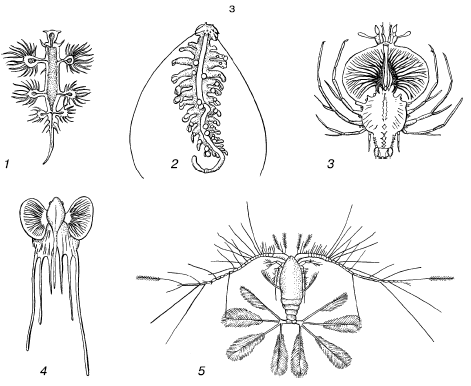
B - dismembered forms:
1 - mollusk Glaucus atlanticus;
2 - the worm Tomopetris euchaeta;
3 - Palinurus crayfish larva;
4 - larva of the fish of the monkfish Lophius;
5 - copepod Calocalanus pavo
The plankton contains unicellular and colonial algae, protozoa, jellyfish, siphonophores, ctenophores, pterygopods and keeled molluscs, various small crustaceans, larvae of benthic animals, fish eggs and fry, and many others (Fig. 39). Planktonic organisms have many similar adaptations that increase their buoyancy and prevent them from sinking to the bottom. Such devices include: 1) a general increase in the relative surface of the body due to a decrease in size, flattening, elongation, the development of numerous outgrowths or bristles, which increases friction against water; 2) a decrease in density due to the reduction of the skeleton, the accumulation of fats, gas bubbles, etc. in the body. In diatoms, reserve substances are deposited not in the form of heavy starch, but in the form of fat droplets. Nightlight Noctiluca is distinguished by such an abundance of gas vacuoles and fat droplets in the cell that the cytoplasm in it looks like strands that fuse only around the nucleus. Siphonophores, a number of jellyfish, planktonic gastropods, etc. also have air chambers.
Seaweed (phytoplankton) hover in water passively, while most planktonic animals are capable of active swimming, but within limited limits. Planktonic organisms cannot overcome currents and are carried over long distances by them. Many kinds zooplankton are capable, however, of vertical migrations in the water column for tens and hundreds of meters, both due to active movement and due to the regulation of the buoyancy of their body. A special type of plankton is the ecological group neuston ("Nein" - to swim) - the inhabitants of the surface film of water at the border with the air environment.
The density and viscosity of water greatly affects the ability to swim actively. Animals capable of fast swimming and overcoming the force of currents are united into an ecological group nekton ("Nektos" - floating). Representatives of nekton are fish, squid, dolphins. Rapid movement in the water column is possible only if there is a streamlined body shape and highly developed muscles. The torpedo shape is developed in all good swimmers, regardless of their systematic affiliation and method of movement in the water: reactive, due to bending of the body, with the help of limbs.
Oxygen mode. In oxygenated water, its content does not exceed 10 ml per 1 liter, which is 21 times lower than in the atmosphere. Therefore, the conditions for the respiration of aquatic organisms are significantly complicated. Oxygen enters the water mainly through the photosynthetic activity of algae and diffusion from the air. Therefore, the upper layers of the water column, as a rule, are richer in this gas than the lower ones. With increasing temperature and salinity of water, the concentration of oxygen in it decreases. In layers heavily populated with animals and bacteria, a sharp O 2 deficiency can be created due to its increased consumption. For example, in the World Ocean, depths from 50 to 1000 m rich in life are characterized by a sharp deterioration in aeration - it is 7-10 times lower than in surface waters inhabited by phytoplankton. Near the bottom of water bodies, conditions can be close to anaerobic.
Among aquatic inhabitants there are many species that can tolerate wide fluctuations in the oxygen content in water, up to its almost complete absence. (euryoxybionts - "oxy" - oxygen, "biont" - inhabitant). These include, for example, the freshwater oligochaetes Tubifex tubifex and the gastropods Viviparus viviparus. Among fish, carp, tench, and crucian carp can withstand very weak oxygen saturation of water. However, a number of types stenoxybionts - they can exist only with a sufficiently high saturation of water with oxygen (rainbow trout, brown trout, minnow, ciliated worm Planaria alpina, larvae of mayflies, stoneflies, etc.). Many species are capable of falling into an inactive state with a lack of oxygen - anoxybiosis - and thus experience an unfavorable period.
Respiration of aquatic organisms is carried out either through the surface of the body, or through specialized organs - gills, lungs, trachea. In this case, the integument can serve as an additional respiratory organ. For example, a loach fish consumes up to 63% of oxygen through the skin on average. If gas exchange occurs through the integuments of the body, then they are very thin. Breathing is also made easier by the increased surface area. This is achieved during the evolution of species by the formation of various outgrowths, flattening, lengthening, and a general decrease in body size. Some species, with a lack of oxygen, actively change the size of the respiratory surface. The Tubifex tubifex worms stretch the body strongly; hydras and anemones - tentacles; echinoderms - ambulacral legs. Many sedentary and sedentary animals renew the water around them, either by creating a directed current of it, or by oscillating movements contributing to its mixing. For this purpose, bivalves are served by cilia lining the walls of the mantle cavity; crustaceans - the work of the abdominal or thoracic legs. Leeches, larvae of bell mosquitoes (bloodworms), many oligochaetes wiggle their bodies, leaning out of the ground.
In some species, a combination of water and air respiration is found. These are lung-breathing fish, siphonophores discophants, many pulmonary mollusks, crustaceans Gammarus lacustris, etc. Secondary animals usually retain the atmospheric type of respiration as energetically more beneficial and therefore need contacts with the air environment, for example, pinnipeds, cetaceans, water beetles, mosquito larvae and others.
Lack of oxygen in water sometimes leads to catastrophic phenomena - zamora, accompanied by the death of many aquatic organisms. Winter zamory often caused by the formation of ice on the surface of reservoirs and the termination of contact with air; summer- an increase in the temperature of water and a decrease, as a result, of the solubility of oxygen.
Frequent death of fish and many invertebrates in winter is characteristic, for example, for the lower part of the Ob river basin, the waters of which, flowing down from the swampy areas of the West Siberian lowland, are extremely poor in dissolved oxygen. Sometimes deaths occur in the seas.
In addition to the lack of oxygen, kills can be caused by an increase in the concentration of toxic gases in the water - methane, hydrogen sulfide, CO 2, etc., formed as a result of the decomposition of organic materials at the bottom of reservoirs.
Salt mode. Maintaining the water balance of aquatic organisms has its own specifics. If for terrestrial animals and plants it is most important to provide the body with water in conditions of its deficiency, then for aquatic organisms it is equally important to maintain a certain amount of water in the body with its excess in the environment. An excessive amount of water in cells leads to a change in osmotic pressure and disruption of the most important vital functions.
Most aquatic life poikilosmotic: the osmotic pressure in their body depends on the salinity of the surrounding water. Therefore, the main way for aquatic organisms to maintain their salt balance is to avoid habitats with inappropriate salinity. Freshwater forms cannot exist in the seas, sea forms cannot tolerate desalination. If the salinity of the water is subject to change, animals move in search of a favorable environment. For example, during desalination of the surface layers of the sea after heavy rains, radiolarians, sea crustaceans Calanus and others descend to a depth of 100 m. Vertebrates, higher crayfish, insects and their larvae that live in water belong homeosmotic species, maintaining a constant osmotic pressure in the body, regardless of the concentration of salts in the water.
In freshwater species, body juices are hypertonic in relation to the surrounding water. They are at risk of excessive watering if the excess water is not prevented from entering or removed from the body. In protozoa, this is achieved by the work of excretory vacuoles, in multicellular organisms, by removing water through the excretory system. Some ciliates release an amount of water equal to the volume of the body every 2–2.5 minutes. The cell spends a lot of energy to "pump out" excess water. With an increase in salinity, the work of vacuoles slows down. So, in Paramecium shoes with a water salinity of 2.5% o, the vacuole pulsates with an interval of 9 s, at 5% o - 18 s, at 7.5% o - 25 s. At a salt concentration of 17.5% o, the vacuole stops working, since the difference in osmotic pressure between the cell and the environment disappears.
If the water is hypertonic in relation to the body fluids of aquatic organisms, they are at risk of dehydration as a result of osmotic losses. Protection against dehydration is achieved by increasing the concentration of salts in the body of aquatic organisms. Dehydration is prevented by water-impermeable covers of homoiosmotic organisms - mammals, fish, higher crayfish, aquatic insects and their larvae.
Many poikilosmotic species go into an inactive state - suspended animation as a result of a lack of water in the body with an increase in salinity. This is typical of species living in puddles of sea water and in the littoral zone: rotifers, flagellates, ciliates, some crustaceans, Black Sea polychaetes Nereis divesicolor, etc. Salt anabiosis- a means to survive unfavorable periods in conditions of variable salinity of water.
Verily euryhaline there are not so many species among the aquatic inhabitants that can live in both fresh and salt water in an active state. These are mainly species inhabiting river estuaries, estuaries and other brackish water bodies.
Temperature regime water bodies are more stable than on land. This is due to the physical properties of water, primarily the high specific heat capacity, due to which the receipt or release of a significant amount of heat does not cause too sharp changes in temperature. Evaporation of water from the surface of reservoirs, in which about 2263.8 J / g is spent, prevents overheating of the lower layers, and the formation of ice, in which the heat of fusion is released (333.48 J / g), slows down their cooling.
The amplitude of annual temperature fluctuations in the upper layers of the ocean is no more than 10–15 ° C, in continental water bodies - 30–35 ° C. Deep layers of water are characterized by constant temperature. In equatorial waters, the average annual temperature of the surface layers is + (26–27) ° С, in polar waters - about 0 ° C and below. In hot terrestrial springs, the water temperature can approach +100 ° C, and in underwater geysers at high pressure at the bottom of the ocean, a temperature of +380 ° C is recorded.
Thus, there is a fairly significant variety of temperature conditions in water bodies. Between the upper layers of water with seasonal temperature fluctuations expressed in them and the lower ones, where the thermal regime is constant, there is a zone of temperature jump, or thermocline. The thermocline is more pronounced in warm seas, where the temperature difference between the external and deep waters is stronger.
Due to the more stable temperature regime of water among aquatic organisms, stenotherm is widespread to a much greater extent than among the land population. Eurythermal species are found mainly in shallow continental water bodies and in the littoral of the seas of high and temperate latitudes, where daily and seasonal temperature fluctuations are significant.
Light mode. There is much less light in water than in air. Part of the rays falling on the surface of the reservoir is reflected into the air. The lower the position of the Sun, the stronger the reflection, so the day is shorter under water than on land. For example, a summer day near Madeira Island at a depth of 30 m - 5 hours, and at a depth of 40 m, only 15 minutes. The rapid decrease in the amount of light with depth is associated with its absorption by water. Rays with different wavelengths are absorbed differently: the red ones disappear already close to the surface, while the blue-green ones penetrate much deeper. Twilight deepening with depth in the ocean is first green, then blue, blue and blue-violet, finally giving way to constant darkness. Accordingly, green, brown and red algae, specialized in capturing light with different wavelengths, replace each other with depth.
The color of animals changes with depth in the same way. The inhabitants of the littoral and sublittoral zones are most vividly and variedly colored. Many deep-seated organisms, like cave organisms, do not have pigments. In the twilight zone, a red coloration is widespread, which is complementary to the blue-violet light at these depths. The rays complementary in color are most fully absorbed by the body. This allows animals to hide from enemies, since their red color in blue-violet rays is visually perceived as black. Red coloration is typical for such animals of the twilight zone as sea bass, red coral, various crustaceans, etc.
In some species living near the surface of water bodies, the eyes are divided into two parts with different ability to refract rays. One half of the eye sees in the air, the other in the water. Such "four-eyed" is typical for beetles-twirling, American fish Anableps tetraphthalmus, one of the tropical species of sea dogs Dialommus fuscus. At low tide, this fish sits in recesses, exposing part of its head out of the water (see Fig. 26).
The absorption of light is the stronger, the lower the transparency of the water, which depends on the amount of particles suspended in it.
Transparency is characterized by the extreme depth at which a specially lowered white disc with a diameter of about 20 cm (Secchi disc) is still visible. The most transparent waters are in the Sargasso Sea: the disc is visible to a depth of 66.5 m. In the Pacific Ocean, the Secchi disc is visible up to 59 m, in the Indian Ocean - up to 50, in shallow seas - up to 5-15 m. The average transparency of rivers is 1–1 , 5 m, and in the most muddy rivers, for example, in the Central Asian Amu Darya and Syrdarya, only a few centimeters. The boundary of the photosynthetic zone therefore varies greatly in different water bodies. In the purest waters euphotic zone, or zone of photosynthesis, extends to depths of no more than 200 m, twilight, or dysphotic, the zone occupies depths of up to 1000-1500 m, and deeper, in aphotic zone, sunlight does not penetrate at all.
The amount of light in the upper layers of water bodies varies greatly depending on the latitude of the area and on the season. Long polar nights severely limit the time available for photosynthesis in the Arctic and Antarctic basins, and ice cover makes it difficult for light in winter to access all freezing water bodies.
In the dark depths of the ocean, organisms use the light emitted by living things as a source of visual information. The glow of a living organism is called bioluminescence. Luminous species are found in almost all classes of aquatic animals, from protozoa to fish, as well as among bacteria, lower plants and fungi. Bioluminescence appears to have arisen many times in different groups at different stages of evolution.
The chemistry of bioluminescence is now fairly well understood. The reactions used to generate light are varied. But in all cases, this is the oxidation of complex organic compounds. (luciferins) using protein catalysts (luciferase). Luciferins and luciferases have different structures in different organisms. During the reaction, the excess energy of the excited luciferin molecule is released in the form of light quanta. Living organisms emit light in pulses, usually in response to stimuli from the external environment.
Luminescence may not play a special ecological role in the life of the species, but be a by-product of the vital activity of cells, as, for example, in bacteria or lower plants. It receives ecological significance only in animals with a sufficiently developed nervous system and organs of vision. In many species, the luminescence organs acquire a very complex structure with a system of reflectors and lenses that amplify the radiation (Fig. 40). A number of fish and cephalopods, unable to generate light, use symbiotic bacteria that multiply in special organs of these animals.
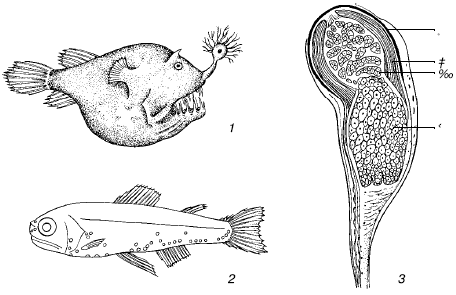
Rice. 40. Glow organs of aquatic animals (according to S.A.Zernov, 1949):
1 - deep-sea angler with a flashlight over the toothed mouth;
2 - distribution of luminous organs in fish of this. Mystophidae;
3 - the luminous organ of the fish Argyropelecus affinis:
a - pigment, b - reflector, c - luminous body, d - lens
Bioluminescence is mainly of signal importance in the life of animals. Light signals can serve for orientation in a flock, attracting individuals of the opposite sex, luring victims, camouflage or distraction. A flash of light can be a defense against a predator, blinding or disorienting it. For example, deep-sea cuttlefish, fleeing from the enemy, release a cloud of luminous secretion, while species living in lighted waters use dark liquid for this purpose. In some benthic worms - polychaetes - luminous organs develop by the period of maturation of the reproductive products, and they glow brighter than the female, and the eyes are better developed in males. In predatory deep-sea fish from the anglerfish order, the first ray of the dorsal fin is shifted to the upper jaw and turned into a flexible "rod" carrying a worm-like "bait" at the end - a gland filled with mucus with luminous bacteria. By regulating the flow of blood to the gland and, consequently, the supply of oxygen to the bacteria, the fish can arbitrarily cause the "bait" to glow, imitating the movements of the worm and luring the prey.
In a terrestrial environment, bioluminescence is developed only in a few species, most of all in beetles from the firefly family, which use light signaling to attract individuals of the opposite sex at twilight or at night.
4.1.3. Some specific adaptations of aquatic organisms
Methods for orienting animals in the aquatic environment. Living in constant twilight or darkness severely limits the possibilities visual orientation hydrobionts. Due to the rapid attenuation of light rays in water, even the owners of well-developed organs of vision are guided with their help only at a close distance.
Sound travels faster in water than in air. Sound orientation is generally better developed in aquatic organisms than visual. A number of types even pick up very low frequency vibrations (infrasounds), arising when the rhythm of the waves changes, and descends in advance before the storm from the surface layers to deeper ones (for example, jellyfish). Many inhabitants of water bodies - mammals, fish, molluscs, crustaceans - make sounds themselves. Crustaceans do this by rubbing different parts of the body against each other; fish - with the help of the swim bladder, pharyngeal teeth, jaws, rays of the pectoral fins, and in other ways. Sound signaling is most often used for intraspecific relationships, for example, for orientation in a flock, attracting individuals of the opposite sex, etc., and is especially developed in inhabitants of turbid waters and great depths living in the dark.
A number of aquatic organisms find food and navigate using echolocation- perception of reflected sound waves (cetaceans). Many perceive reflected electrical impulses, producing discharges of different frequencies during swimming. There are about 300 species of fish known to generate electricity and use it for orientation and signaling. The freshwater elephant fish (Mormyrus kannume) sends out up to 30 pulses per second, detecting invertebrates, which it hunts in liquid silt without the aid of sight. The frequency of discharges in some marine fish reaches 2000 impulses per second. A number of fish also use electric fields for defense and attack (electric ray, electric eel, etc.).
For orientation in depth use perception of hydrostatic pressure. It is carried out with the help of statocysts, gas chambers and other organs.
The most ancient way of orientation common to all aquatic animals is perception of the chemistry of the environment. The chemoreceptors of many aquatic organisms are extremely sensitive. In the thousand-kilometer migrations, which are characteristic of many species of fish, they are guided mainly by smells, finding spawning or feeding grounds with amazing accuracy. It has been experimentally proved, for example, that salmon, artificially deprived of their sense of smell, do not find the mouth of their river, returning to spawn, but they never make mistakes if they can perceive smells. The subtlety of smell is extremely high in fish making especially distant migrations.
Specificity of adaptations to life in drying up water bodies. On Earth, there are many temporary, shallow water bodies that arise after the flooding of rivers, heavy rains, melting snow, etc. In these water bodies, despite the brevity of their existence, a variety of aquatic organisms settle.
Common features of the inhabitants of drying up pools are the ability to give numerous offspring in a short time and endure long periods without water. At the same time, representatives of many species are buried in silt, passing into a state of reduced vital activity - hypobiosis. This is the behavior of shtitti, cladocerans, planaria, small-bristled worms, molluscs and even fish - loach, African protopterus and South American lepidosiren from lungs. Many small species form cysts that can withstand drought, such as sunflowers, ciliates, rhizopods, a number of copepods, turbellaria, and nematodes of the genus Rhabditis. Others go through an unfavorable period in the highly resistant egg stage. Finally, some small inhabitants of drying up water bodies have a unique ability to dry out to a film state, and, when moistened, resume growth and development. The ability to endure complete dehydration of the body was revealed in rotifers of the genera Callidina, Philodina, etc., tardigrades Macrobiotus, Echiniscus, nematodes of the genera Tylenchus, Plectus, Cephalobus, etc. These animals inhabit micro-reservoirs in the cushions of moss and lichens and are adapted to abrupt changes in the moisture regime.
Filtration as a type of food. Many aquatic organisms have a special feeding pattern - it is strain or sedimentation of particles of organic origin suspended in water and numerous small organisms (Fig. 41).
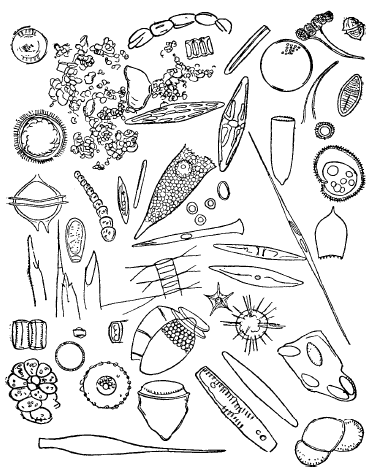
Rice. 41. Composition of plankton food of ascidians from the Barents Sea (according to S.A.Zernov, 1949)
This method of feeding, which does not require large expenditures of energy for searching for prey, is characteristic of lamellar gill mollusks, sessile echinoderms, polychaetes, bryozoans, ascidians, planktonic crustaceans, etc. (Fig. 42). Filtration animals play an essential role in biological treatment of water bodies. Mussels living on an area of 1 m 2 can drive 150–280 m 3 of water through the mantle cavity per day, precipitating suspended particles. Freshwater daphnia, cyclops or the most abundant crustacean Calanus finmarchicus in the ocean filter up to 1.5 liters of water per individual per day. The littoral zone of the ocean, especially rich in accumulations of filtering organisms, works as an effective purification system.
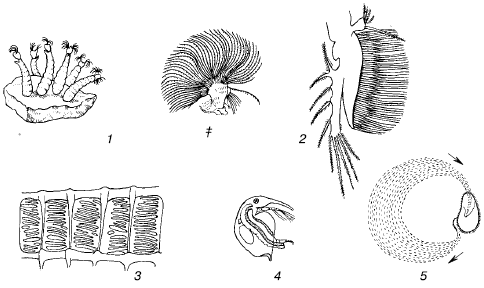
Rice. 42. Filtering devices of aquatic organisms (according to S.A.Zernov, 1949):
1 - larvae of Simulium midges on a stone (a) and their filtering appendages (b);
2 - filtering leg of the crustacean Diaphanosoma brachyurum;
3 - gill slits of the ascidian Phasullia;
4 - Bosmina crustacean with filtered intestinal contents;
5 - food current of ciliates Bursaria
The properties of the environment largely determine the ways of adaptation of its inhabitants, their way of life and ways of using resources, creating a chain of cause-and-effect relationships. Thus, the high density of water makes possible the existence of plankton, and the presence of organisms floating in the water is a prerequisite for the development of a filtration type of nutrition, in which a sedentary lifestyle of animals is also possible. As a result, a powerful mechanism of self-purification of reservoirs of biospheric importance is formed. It involves a huge number of aquatic organisms, both benthic and pelagic, from unicellular protozoa to vertebrates. According to calculations, all the water in the lakes of the temperate zone is passed through the filtration devices of animals from several to tens of times during the growing season, and the entire volume of the World Ocean is filtered within several days. Disruption of filter feeders by various anthropogenic influences poses a serious threat to maintaining the purity of waters.
4.2. Ground-air environment of life
The ground-air environment is the most difficult in terms of environmental conditions. Life on land demanded such adaptations that were possible only with a sufficiently high level of organization of plants and animals.
4.2.1. Air as an environmental factor for terrestrial organisms
Low air density determines its low lift and insignificant controversy. Inhabitants of the air environment must have their own support system that supports the body: plants - a variety of mechanical tissues, animals - a solid or, much less often, a hydrostatic skeleton. In addition, all inhabitants of the air environment are closely connected with the surface of the earth, which serves them for attachment and support. Suspended life in air is impossible.
True, many microorganisms and animals, spores, seeds, fruits and pollen of plants are regularly present in the air and are carried by air currents (Fig. 43), many animals are capable of active flight, but in all these species the main function of their life cycle - reproduction - is carried out on the surface of the earth. For most of them, staying in the air is associated only with settling or searching for prey.
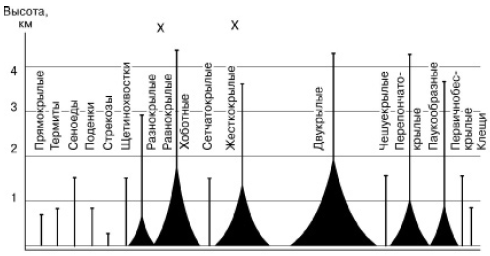
Rice. 43. Distribution of aerial plankton arthropods by height (according to Dajo, 1975)
Low air density results in low resistance to movement. Therefore, many terrestrial animals have used in the course of evolution the ecological benefits of this property of the air, acquiring the ability to fly. 75% of species of all terrestrial animals, mainly insects and birds, are capable of active flight, but flyers are also found among mammals and reptiles. Land animals fly mainly with the help of muscular efforts, but some can also glide due to air currents.
Due to the mobility of air, the vertical and horizontal movements of air masses existing in the lower layers of the atmosphere, passive flight of a number of organisms is possible.
Anemophilia - the oldest method of pollination of plants. All gymnosperms are pollinated by the wind, and among angiosperms, anemophilous plants make up about 10% of all species.
Anemophilia is observed in the families of beech, birch, walnut, elm, hemp, nettle, casuarine, haze, sedge, cereals, palms and many others. Wind-pollinated plants have a number of adaptations that improve the aerodynamic properties of their pollen, as well as morphological and biological features that ensure the efficiency of pollination.
The life of many plants is completely dependent on the wind, and resettlement is carried out with its help. Such a double dependence is observed in spruces, pines, poplars, birches, elms, ash trees, cotton grass, cattails, saxauls, juzguns, etc.
Many species have developed anemochoria- resettlement by means of air currents. Anemochoria is characteristic of spores, seeds and fruits of plants, cysts of protozoa, small insects, spiders, etc. Organisms passively carried by air currents are collectively called air plankton by analogy with planktonic inhabitants of the aquatic environment. Special adaptations for passive flight are very small body sizes, an increase in its area due to outgrowths, strong dissection, a large relative surface of the wings, the use of cobwebs, etc. (Fig. 44). Anemochoral seeds and fruits of plants also have either very small sizes (for example, orchid seeds), or various pterygoid and parachute-like appendages that increase their ability to glide (Fig. 45).
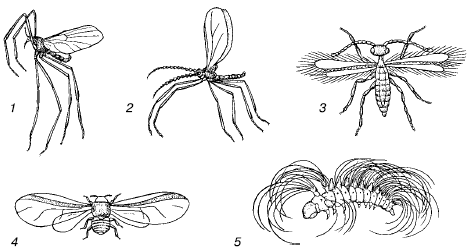
Rice. 44. Airborne insect adaptations:
1 - mosquito Cardiocrepis brevirostris;
2 - gall midge Porrycordila sp .;
3 - Hymenoptera Anargus fuscus;
4 - Hermes Dreyfusia nordmannianae;
5 - the larva of the gypsy moth Lymantria dispar
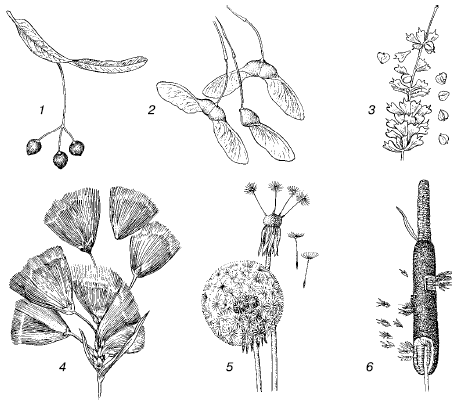
Rice. 45. Adaptations for wind transport in fruits and seeds of plants:
1 - linden Tilia intermedia;
2 - Acer monspessulanum maple;
3 - birch Betula pendula;
4 - cotton grass Eriophorum;
5 - Dandelion Taraxacum officinale;
6 - cattail Typha scuttbeworhii
In the dispersal of microorganisms, animals and plants, the main role is played by vertical convection air currents and weak winds. High winds, storms and hurricanes also have significant environmental impacts on terrestrial organisms.
Low air density leads to a relatively low pressure on land. Normally, it is equal to 760 mm Hg. Art. With increasing altitude, the pressure decreases. At an altitude of 5800 m, it is only half the normal. Low pressure can restrict the distribution of species in the mountains. For most vertebrates, the upper limit of life is about 6000 m. A decrease in pressure entails a decrease in oxygen supply and dehydration of animals due to an increase in the respiratory rate. Approximately the same are the limits of higher plants' advancement into the mountains. Somewhat more hardy are arthropods (springtails, ticks, spiders), which can be found on glaciers, above the vegetation boundary.
In general, all terrestrial organisms are much more stenobathic than aquatic ones, since the usual fluctuations in pressure in their environment make up fractions of the atmosphere and even for birds that rise to great heights do not exceed 1/3 normal.
Gas composition of air. In addition to the physical properties of the air, its chemical characteristics are extremely important for the existence of terrestrial organisms. The gas composition of the air in the surface layer of the atmosphere is quite homogeneous with respect to the content of the main components (nitrogen - 78.1%, oxygen - 21.0, argon - 0.9, carbon dioxide - 0.035% by volume) due to the high diffusion capacity of gases and constant mixing convection and wind flows. However, various impurities of gaseous, droplet-liquid and solid (dust) particles entering the atmosphere from local sources can be of significant environmental significance.
The high oxygen content promoted an increase in the metabolism of terrestrial organisms in comparison with primary aquatic organisms. It was in the terrestrial environment, on the basis of the high efficiency of oxidative processes in the body, that animal homeothermy arose. Oxygen, due to its constantly high content in the air, is not a factor limiting life in a terrestrial environment. Only in places, under specific conditions, is it temporarily deficient, for example, in accumulations of decaying plant residues, stocks of grain, flour, etc.
The carbon dioxide content can vary in certain areas of the surface air layer within fairly significant limits. For example, in the absence of wind in the center of large cities, its concentration increases tenfold. Diurnal changes in the carbon dioxide content in the surface layers associated with the rhythm of plant photosynthesis are natural. Seasonal ones are caused by changes in the intensity of respiration of living organisms, mainly of the microscopic population of soils. Increased air saturation with carbon dioxide occurs in zones of volcanic activity, near thermal springs and other underground outlets of this gas. In high concentrations, carbon dioxide is toxic. In nature, such concentrations are rare.
In nature, the main source of carbon dioxide is the so-called soil respiration. Soil microorganisms and animals breathe very intensively. Carbon dioxide diffuses from the soil into the atmosphere, especially when it rains. A lot of it is emitted by soils of moderately moist, well-warmed, rich in organic residues. For example, the soil of a beech forest emits CO 2 from 15 to 22 kg / ha per hour, and unfertilized sandy soil only 2 kg / ha.
In modern conditions, human activities to burn fossil fuel reserves have become a powerful source of additional amounts of CO 2 into the atmosphere.
Air nitrogen for most inhabitants of the terrestrial environment is an inert gas, but a number of prokaryotic organisms (nodule bacteria, azotobacter, clostridia, blue-green algae, etc.) have the ability to bind it and involve it in the biological circulation.

Rice. 46. A mountain slope with destroyed vegetation due to emissions of sulfur dioxide from the surrounding industrial enterprises
Local impurities entering the air can also significantly affect living organisms. This especially applies to poisonous gaseous substances - methane, sulfur oxide, carbon monoxide, nitrogen oxide, hydrogen sulfide, chlorine compounds, as well as particles of dust, soot, etc., clogging the air in industrial areas. The main modern source of chemical and physical pollution of the atmosphere is anthropogenic: the work of various industrial enterprises and transport, soil erosion, etc. Sulfur oxide (SO 2), for example, is poisonous to plants even in concentrations from one fifty thousandth to one millionth of the air volume. Almost all vegetation perishes around industrial centers that pollute the atmosphere with this gas (Fig. 46). Some plant species are especially sensitive to SO 2 and serve as a sensitive indicator of its accumulation in the air. For example, many lichens die even with traces of sulfur oxide in the surrounding atmosphere. Their presence in the forests around large cities testifies to the high purity of the air. The resistance of plants to impurities in the air is taken into account when selecting species for landscaping in settlements. Smoke sensitive, for example, spruce and pine, maple, linden, birch. The most resistant are thuja, Canadian poplar, American maple, elderberry and some others.
4.2.2. Soil and relief. Weather and climatic features of the ground-air environment
Edaphic environmental factors. The properties of the soil and the terrain also affect the living conditions of terrestrial organisms, primarily plants. The properties of the earth's surface, which have an ecological impact on its inhabitants, are united by the name edaphic environmental factors (from the Greek "edaphos" - base, soil).
The nature of the root system of plants depends on the hydrothermal regime, aeration, constitution, composition and structure of the soil. For example, the root systems of tree species (birch, larch) in areas with permafrost are located at a shallow depth and spread in breadth. Where there is no permafrost, the root systems of the same plants are less spread and penetrate deeper. In many steppe plants, the roots can get water from a great depth, at the same time, they also have many surface roots in the humus horizon of the soil, from where the plants absorb elements of mineral nutrition. On waterlogged, poorly aerated soil in mangrove thickets, many species have special respiratory roots - pneumatophores.
A number of ecological groups of plants can be distinguished in relation to different properties of soils.
So, according to the reaction to soil acidity, they are distinguished: 1) acidophilic species - grow on acidic soils with a pH of less than 6.7 (sphagnum bog plants, whitewings); 2) neutrophilic - gravitate towards soils with a pH of 6.7–7.0 (most cultivated plants); 3) basiphilic- grow at pH more than 7.0 (mordovnik, forest anemone); 4) indifferent - can grow on soils with different pH values (lily of the valley, sheep's fescue).
In relation to the gross composition of the soil, there are: 1) oligotrophic plants that are content with a small amount of ash elements (Scots pine); 2) eutrophic, those in need of a large number of ash elements (oak, common runny, perennial forest grower); 3) mesotrophic, requiring a moderate amount of ash elements (common spruce).
Nitrophils- Plants that prefer nitrogen-rich soils (stinging nettle).
Saline soil plants make up a group halophytes(salleros, sarsazan, kokpek).
Some plant species are confined to different substrates: petrophytes grow on stony soils, and psammophytes populate loose sands.
The terrain and the nature of the ground affect the specificity of the movement of animals. For example, ungulates, ostriches, and bustards living in open spaces need solid ground to enhance repulsion when running fast. In lizards living on loose sand, the fingers are bordered by a fringe of horny scales, which increases the surface of the support (Fig. 47). For terrestrial inhabitants digging holes, dense soils are unfavorable. The nature of the soil in some cases affects the distribution of terrestrial animals that burrow, burrow into the ground to escape the heat or predators, or lay eggs in the soil, etc.
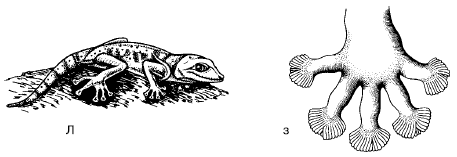
Rice. 47. Fan-toed gecko - an inhabitant of the sands of the Sahara: A - fan-toed gecko; B - leg of a gecko
Weather features. Living conditions in the ground-air environment are complicated, in addition, weather changes. Weather - This is a continuously changing state of the atmosphere near the earth's surface up to an altitude of about 20 km (the border of the troposphere). The variability of the weather manifests itself in the constant variation of the combination of such environmental factors as air temperature and humidity, cloudiness, precipitation, wind strength and direction, etc. terrestrial organisms. The weather affects the life of aquatic inhabitants to a much lesser extent and only on the population of the surface layers.
The climate of the area. Long-term weather regime characterizes the climate of the area. The concept of climate includes not only the average values of meteorological phenomena, but also their annual and daily variation, deviations from it and their frequency. The climate is determined by the geographic conditions of the area.
The zonal diversity of climates is complicated by the effect of monsoon winds, the distribution of cyclones and anticyclones, the influence of mountain ranges on the movement of air masses, the degree of distance from the ocean (continentality), and many other local factors. In the mountains, there is a climatic zonation, in many respects similar to the change of zones from low latitudes to high latitudes. All this creates an extraordinary variety of living conditions on land.
For most terrestrial organisms, especially small ones, it is not so much the climate of the region that is important as the conditions of their immediate habitat. Very often, local elements of the environment (relief, exposure, vegetation, etc.) change the mode of temperature, humidity, light, air movement in a particular area in such a way that it differs significantly from the climatic conditions of the area. Such local climate modifications that develop in the surface air layer are called microclimate. Microclimates are very diverse in each zone. Microclimates of arbitrarily small areas can be distinguished. For example, a special regime is created in the corolla of flowers, which is used by insects living there. The differences in temperature, air humidity and wind force in open space and in the forest, in grass and above bare soil areas, on the slopes of northern and southern exposures, etc. are widely known. A special stable microclimate occurs in burrows, nests, hollows, caves and others. closed places.
Precipitation. In addition to water supply and moisture storage, they can play another ecological role. Thus, heavy torrential rains or hail sometimes have a mechanical effect on plants or animals.
The ecological role of the snow cover is especially diverse. Daily temperature fluctuations penetrate into the snow thickness only up to 25 cm, deeper the temperature hardly changes. With frosts of -20-30 ° C under a layer of snow of 30-40 cm, the temperature is only slightly below zero. Deep snow cover protects the buds of renewal, protects green parts of plants from freezing; many species go under the snow without shedding their foliage, for example, hairy peel, Veronica officinalis, clefthoof, etc.

Rice. 48. Scheme of telemetric study of the temperature regime of hazel grouse, located in a snowy hole (according to A.V. Andreev, A.V. Krechmar, 1976)
Small land animals also lead an active lifestyle in winter, laying whole galleries of passages under the snow and in its thickness. For a number of species feeding on snowy vegetation, even winter reproduction is characteristic, which is noted, for example, in lemmings, wood and yellow-throated mice, a number of voles, water rats, etc. fig. 48).
Winter snow cover prevents large animals from getting food. Many ungulates (reindeer, wild boars, musk oxen) feed exclusively on snowy vegetation in winter, and deep snow cover, and especially a hard crust on its surface, which appears in ice, doom them to lack of food. During nomadic cattle breeding in pre-revolutionary Russia, a huge disaster in the southern regions was jute - mass deaths of livestock as a result of ice, depriving animals of food. Moving on loose deep snow is also difficult for animals. Foxes, for example, in snowy winters prefer areas in the forest under dense spruce trees, where the layer of snow is thinner, and almost never go to open meadows and forest edges. The depth of snow cover can limit the geographic distribution of species. For example, real deer do not penetrate north to those areas where the thickness of snow in winter is more than 40-50 cm.
The whiteness of the snow cover reveals the dark animals. In the occurrence of seasonal color changes in white and tundra partridges, white hare, ermine, weasel, Arctic fox, selection for disguise for the background color apparently played an important role. On the Commander Islands, along with whites, there are many blue foxes. According to the observations of zoologists, the latter stay mainly near dark rocks and non-freezing surf strip, while whites prefer areas with snow cover.
4.3. Soil as a habitat
4.3.1. Soil features
The soil is a loose thin surface layer of land in contact with the air. Despite its insignificant thickness, this shell of the Earth plays a critical role in the spread of life. The soil is not just a solid, like most rocks of the lithosphere, but a complex three-phase system in which solid particles are surrounded by air and water. It is permeated with cavities filled with a mixture of gases and aqueous solutions, and therefore extremely diverse conditions are formed in it, favorable for the life of many micro- and macroorganisms (Fig. 49). In the soil, temperature fluctuations are smoothed out in comparison with the surface air layer, and the presence of groundwater and the penetration of precipitation create moisture reserves and provide a moisture regime intermediate between the aquatic and terrestrial environment. The soil concentrates stocks of organic and mineral substances supplied by dying vegetation and animal corpses. All this determines the high saturation of the soil with life.
The root systems of terrestrial plants are concentrated in the soil (Fig. 50).
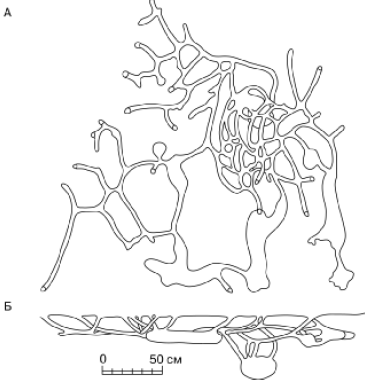
Rice. 49. Underground passages of Brandt's vole: A - top view; B - side view
Rice. 50. Placement of roots in the steppe chernozem soil (after M.S.Shalyt, 1950)
On average, 1 m 2 of the soil layer accounts for more than 100 billion cells of protozoa, millions of rotifers and tardigrades, tens of millions of nematodes, tens and hundreds of thousands of ticks and collembolans, thousands of other arthropods, tens of thousands of enchitreids, tens and hundreds of earthworms, molluscs and other invertebrates ... In addition, 1 cm 2 of soil contains tens and hundreds of millions of bacteria, microscopic fungi, actinomycetes and other microorganisms. In the illuminated surface layers, hundreds of thousands of photosynthetic cells of green, yellow-green, diatoms and blue-green algae live in each gram. Living organisms are as characteristic of the soil as its non-living components. Therefore, V.I.Vernadsky referred the soil to the bio-inert bodies of nature, emphasizing the richness of its life and its inextricable connection with it.
The heterogeneity of conditions in the soil is most pronounced in the vertical direction. A number of the most important ecological factors affecting the life of the inhabitants of the soil change sharply with depth. First of all, this applies to the structure of the soil. Three main horizons are distinguished in it, differing in morphological and chemical properties: 1) the upper humus-accumulative horizon A, in which organic matter is accumulated and transformed and from which some of the compounds are carried down by washing waters; 2) the wash-in horizon, or illuvial B, where the substances washed out from above settle and transform, and 3) the parent rock, or the C horizon, the material of which is transformed into soil.
Within each horizon, more fractional layers are distinguished, which also greatly differ in properties. For example, in a temperate zone under coniferous or mixed forests, the horizon A consists of litter (A 0)- a layer of loose accumulation of plant residues, a dark-colored humus layer (A 1), in which particles of organic origin are mixed with mineral, and podzolic layer (A 2)- ash-gray in color, in which silicon compounds predominate, and all soluble substances are washed into the depth of the soil profile. Both the structure and the chemistry of these layers are very different, and therefore the roots of plants and soil inhabitants, moving only a few centimeters up or down, find themselves in different conditions.
The size of the cavities between soil particles suitable for animals to inhabit them usually decreases rapidly with depth. For example, in meadow soils, the average diameter of cavities at a depth of 0–1 cm is 3 mm, 1–2 cm - 2 mm, and at a depth of 2–3 cm - only 1 mm; deeper the soil pores are even smaller. Soil density also changes with depth. The most loose are the layers containing organic matter. The porosity of these layers is determined by the fact that organic substances stick together mineral particles into larger aggregates, the volume of the cavities between which increases. The most dense is usually the illuvial horizon. V, cemented by colloidal particles washed in it.
Moisture in the soil is present in various states: 1) bound (hygroscopic and film) is firmly held by the surface of soil particles; 2) the capillary occupies small pores and can move along them in different directions; 3) gravity fills larger voids and slowly seeps down under the influence of gravity; 4) the vapor is contained in the soil air.
The water content is not the same in different soils and at different times. If there is too much gravitational moisture, then the soil regime is close to the regime of water bodies. In dry soil, only bound water remains and conditions approach terrestrial conditions. However, even in the driest soils, the air is more humid than above ground, so the inhabitants of the soil are much less susceptible to the threat of drying out than on the surface.
The composition of soil air is variable. With depth in it, the oxygen content drops sharply and the concentration of carbon dioxide increases. Due to the presence of decomposing organic matter in the soil, the soil air may contain a high concentration of toxic gases such as ammonia, hydrogen sulfide, methane, etc. When the soil is flooded or intensive rotting of plant residues, completely anaerobic conditions may occur in places.
Fluctuations in cutting temperature only on the soil surface. Here they can be even stronger than in the surface air. However, with each centimeter deeper, the diurnal and seasonal temperature changes become less and less and at a depth of 1–1.5 m are practically no longer traced (Fig. 51).
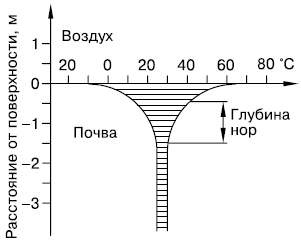
Rice. 51. Decrease in annual fluctuations in soil temperature with depth (according to K. Schmidt-Nilsson, 1972). The shaded part is the range of annual temperature fluctuations
All these features lead to the fact that, despite the great heterogeneity of environmental conditions in the soil, it acts as a fairly stable environment, especially for mobile organisms. The steep gradient of temperature and humidity in the soil profile allows soil animals to provide themselves with a suitable ecological situation through minor movements.
4.3.2. Inhabitants of the soil
The heterogeneity of the soil leads to the fact that for organisms of different sizes it acts as a different environment. For microorganisms, the huge total surface of soil particles is of particular importance, since the overwhelming part of the microbial population is adsorbed on them. The complexity of the soil environment creates a wide variety of conditions for a wide variety of functional groups: aerobes and anaerobes, consumers of organic and mineral compounds. The distribution of microorganisms in the soil is characterized by a small focus, since even within a few millimeters different ecological zones can change.
For small soil animals (Fig. 52, 53), which are combined under the name microfauna (protozoa, rotifers, tardigrades, nematodes, etc.), the soil is a system of micro-reservoirs. Essentially, these are aquatic organisms. They live in soil pores filled with gravitational or capillary water, and part of their life, like microorganisms, can be adsorbed on the surface of particles in thin layers of film moisture. Many of these species also live in ordinary water bodies. However, soil forms are much smaller than freshwater ones and, in addition, are distinguished by their ability to remain in an encysted state for a long time, waiting out unfavorable periods. While freshwater amoebas are 50-100 microns in size, soil ones are only 10-15. Representatives of flagellates are especially small, often only 2–5 µm. Soil ciliates are also dwarf in size and, moreover, can greatly change the shape of the body.
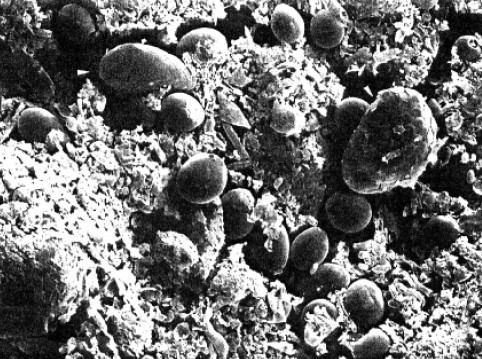
Rice. 52. Shell amoeba feeding on bacteria on decaying leaves of forest floor
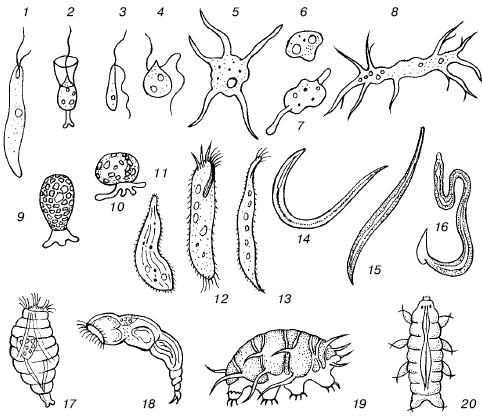
Rice. 53. Soil microfauna (after W. Dunger, 1974):
1–4 - flagellate; 5–8 - naked amoebas; 9-10 - shell amoebas; 11–13 - ciliates; 14–16 - round worms; 17–18 - rotifers; 19–20 – tardigrades
For the somewhat larger animals breathing air, the soil appears as a system of small caves. Such animals are united under the name mesofauna (fig. 54). The sizes of the representatives of the soil mesofauna are from tenths to 2–3 mm. This group includes mainly arthropods: numerous groups of ticks, primary wingless insects (collembolans, protora, two-tails), small species of winged insects, symphila centipedes, etc. They have no special tools for digging. They crawl along the walls of the soil cavities with the help of their limbs or worm-like writhing. The soil air saturated with water vapor allows breathing through the integument. Many species lack a tracheal system. Such animals are very sensitive to drying out. The main means of salvation from fluctuations in air humidity for them is to move inland. But the possibility of migration through the soil cavities inward is limited by a rapid decrease in the pore diameter, therefore, movement through the wells of the soil is available only to the smallest species. Larger representatives of the mesofauna have some adaptations that allow them to endure a temporary decrease in soil air humidity: protective scales on the body, partial impermeability of integuments, a solid thick-walled shell with an epicuticle in combination with a primitive tracheal system that provides respiration.
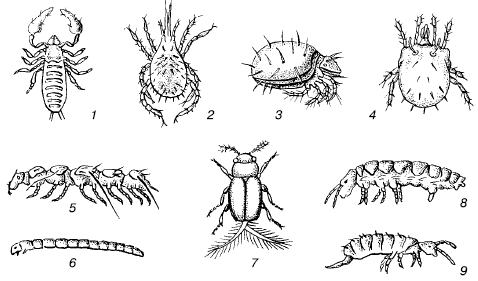
Rice. 54. Mesofauna of soils (no W. Danger, 1974):
1 - false scorion; 2 - din a new flare; 3–4 armored mites; 5 - pauroiod centipede; 6 - Chironomid mosquito larva; 7 - a beetle from this. Ptiliidae; 8–9 collembolans
The representatives of the mesofauna experience periods of soil flooding with water in air bubbles. Air is retained around the body of animals due to their non-wetting covers, which are also supplied with hairs, scales, etc. An air bubble serves as a kind of "physical gill" for a small animal. Breathing is carried out due to oxygen diffusing into the air layer from the surrounding water.
Representatives of micro- and mesofauna are able to withstand winter soil freezing, since most species cannot go down from layers exposed to negative temperatures.
Larger soil animals, with body sizes from 2 to 20 mm, are called representatives macrofauna (fig. 55). These are insect larvae, millipedes, enchitreids, earthworms, etc. For them, the soil is a dense medium that provides significant mechanical resistance when moving. These relatively large forms move in the soil either by expanding natural wells by pushing the soil particles apart, or by digging new passages. Both modes of movement leave an imprint on the external structure of animals.
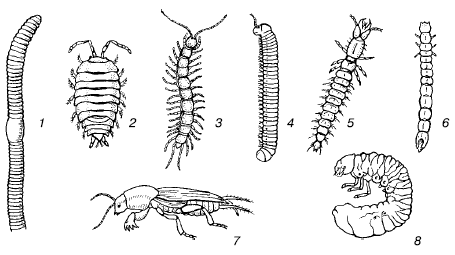
Rice. 55. Macrofauna of soils (no W. Danger, 1974):
1 - earthworm; 2 – wood lice; 3 – labiopod centipede; 4 – two-legged centipede; 5 - ground beetle larva; 6 – nutcracker larva; 7 – bear; 8 - grub larva
The ability to move through thin wells, almost without resorting to digging, is inherent only in species that have a body with a small cross-section, capable of bending strongly in winding passages (centipedes - drupes and geophiles). By pushing the soil particles apart due to the pressure of the body walls, earthworms, larvae of long-legged mosquitoes, etc. move. Having fixed the rear end, they thin and lengthen the front end, penetrating into narrow soil cracks, then fix the front part of the body and increase its diameter. At the same time, in the enlarged area, due to the work of the muscles, a strong hydraulic pressure of the incompressible intracavitary fluid is created: in worms - the contents of the coelomic sacs, and in tipulids - hemolymph. The pressure is transmitted through the walls of the body to the soil, and thus the animal expands the well. At the same time, an open passage remains behind, which threatens with increased evaporation and the pursuit of predators. Many species have developed adaptations to an ecologically more beneficial type of movement in the soil - digging with clogging of the passage behind itself. Digging is carried out by loosening and raking off soil particles. For this, the larvae of various insects use the anterior end of the head, mandibles and forelimbs, expanded and reinforced with a thick layer of chitin, spines and outgrowths. At the posterior end of the body, devices for firm fixation develop - retractable supports, teeth, hooks. To close the passage on the last segments, a number of species have a special depressed platform, framed with chitinous edges or teeth, a kind of wheelbarrow. Similar platforms are formed on the back of the elytra and in bark beetles, which also use them to clog the passages with drill meal. Closing the passage behind them, the animals - the inhabitants of the soil are constantly in a closed chamber, saturated with the vapors of their own bodies.
Gas exchange of most species of this ecological group is carried out with the help of specialized respiratory organs, but at the same time it is supplemented by gas exchange through integuments. It is even possible exclusively skin respiration, for example, in earthworms, enchitreid.
Burrowing animals can leave layers where an unfavorable environment arises. In drought and in winter, they concentrate in deeper layers, usually a few tens of centimeters from the surface.
Megafauna soils are large diggers, mainly mammals. A number of species spend their whole life in the soil (mole rats, mole voles, zokors, moles of Eurasia, golden moles
Africa, Australia's marsupial moles, etc.). They lay whole systems of tunnels and holes in the soil. The external appearance and anatomical features of these animals reflect their adaptability to the burrowing underground lifestyle. They have underdeveloped eyes, a compact, rolling body with a short neck, short thick fur, strong digging limbs with strong claws. Mole and mole rats loosen the ground with incisors. Large oligochaetes, especially representatives of the family Megascolecidae, inhabiting the tropics and the Southern Hemisphere, should also be attributed to the megafauna of the soil. The largest of them, the Australian Megascolides australis, reaches 2.5 and even 3 m in length.
In addition to the permanent inhabitants of the soil, a large ecological group can be distinguished among large animals burrow dwellers (gophers, marmots, jerboas, rabbits, badgers, etc.). They feed on the surface, but reproduce, hibernate, rest, escape from danger in the soil. A number of other animals use their burrows, finding a favorable microclimate in them and shelter from enemies. Norniks have structural features characteristic of terrestrial animals, but they have a number of adaptations associated with a burrowing way of life. For example, badgers have long claws and strong muscles on the forelimbs, a narrow head, and small auricles. In rabbits, in comparison with hares that do not burrow holes, the ears and hind legs are noticeably shortened, the skull is stronger, the bones and muscles of the forearms are more developed, etc.
For a number of ecological features, the soil is an intermediate medium between water and ground. The soil is brought closer to the aquatic environment by its temperature regime, the low oxygen content in the soil air, its saturation with water vapor and the presence of water in other forms, the presence of salts and organic matter in soil solutions, the ability to move in three dimensions.
The soil is brought closer to the air by the presence of soil air, the threat of desiccation in the upper horizons, and rather sharp changes in the temperature regime of the surface layers.
The intermediate ecological properties of soil as an animal habitat suggest that soil played a special role in the evolution of the animal world. For many groups, in particular arthropods, the soil served as a medium through which initially aquatic inhabitants were able to transition to a terrestrial lifestyle and conquer land. This path of evolution of arthropods was proved by the works of M. S. Gilyarov (1912–1985).
4.4. Living organisms as a habitat
Many species of heterotrophic organisms throughout their life or part of the life cycle live in other living beings, whose bodies serve as an environment for them, significantly different in properties from the external one.
Rice. 56. Aphid rider
Rice. 57. Cut gall on a beech leaf with gall midge larva Mikiola fagi







